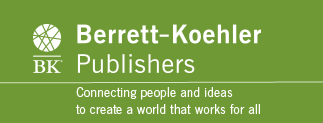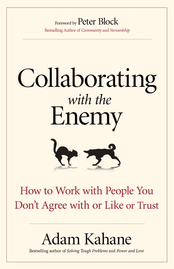Collaborating with the Enemy
1
Collaboration Is Becoming More
Necessary and More Difficult
The urge to form partnerships, to link up in collaborative arrangements, is perhaps the oldest, strongest, and most fundamental force in nature. There are no solitary, free living creatures: every form of life is dependent on other forms.
—Lewis Thomas
1
Collaboration is often imperative and usually challenging. And the more we need it, the more difficult we find it.
“I COULD NEVER WORK WITH THOSE PEOPLE!”
In November 2015, I was facilitating the first workshop of a group of 33 national leaders. They had come together to search for solutions to their country’s most critical problem: the devastating nexus of insecurity, illegality, and inequality. Everyone at the meeting was worried about this situation and determined to do something about it, and they thought that together they might be able to do more than separately. I thought the project was important and was determined to do a good job.
The participants came from every part of the society: politicians, human rights activists, army generals, business owners, religious leaders, trade unionists, intellectuals, journalists. They had deep ideological differences, and many of them were political or professional or personal rivals. Mostly they didn’t agree with or like or trust each other. In the country and in the group, suspicion and defensiveness were sky-high.
To solve their most important problem, these people needed to work together, but they weren’t sure they could.
I thought the workshop was going well. The participants were talking about their very different experiences and perspectives, all together and in small groups, and at meals and on walks and on trips outside the hotel to visit local people and projects. They were cautiously starting to get to know one another and to hope that together they could make a difference.
Then, on the final morning, the project organizing team (eleven locals and my colleagues and me) got into an argument about some things that were not going well: methodological confusions, logistical glitches, communication breakdowns. Some of the organizers thought I was doing a bad job, and the next day they wrote a critical note that they circulated among themselves.
One of the team members forwarded the note to me. I felt off ended and upset that the organizers were challenging my expertise and professionalism behind my back. I was frightened that the accomplishment and income I was expecting from the project were at risk. I thought I needed to defend myself, so I sent off first one, then a second, and then a third email explaining why, in my expert view, what I had done in the workshop had been correct. I knew that I had made some mistakes but was worried that if I admitted these now, I would be opening myself up to greater danger. I was certain that overall I was right and they were wrong: that they were the villains and I was the victimized hero.
As the week went on and I had phone conversations with different organizers, my attitude hardened. I thought the people who were blaming me for the problems we were having were unconscionably betraying our team effort and me. I fought back and blamed them. I became increasingly suspicious, mistrustful, assertive, and rigid. I also wanted to keep myself safe, so I became increasingly cautious and canny. I decided that I didn’t agree with or like or trust these organizers and didn’t want to engage with them on this matter or to work with them anymore. What I really wanted was for them to disappear.
THE ENEMYFYING SYNDROME
This short, sharp conflict enabled me to feel in my gut a challenge that I had been thinking about for a long time. In order to make progress on this project, which was important to me, I needed to work with others. These others included people I did not agree with or like or trust. I slipped into thinking of them as my enemies. This polarization within our team put the work we were doing at risk. Moreover, in this small interaction within our team, we reproduced a central dynamic in the larger national system—mistrust, fragmentation, breakdown—that the project had been established to counter.
In this ordinary incident, I enacted a common behavior or syndrome that I call enemyfying: thinking and acting as if the people we are dealing with are our enemies—people who are the cause of our problems and are hurting us. In different contexts we use different words with subtly different connotations for the people from whom we differentiate ourselves: others, rivals, competitors, opponents, adversaries, enemies. We use these characterizations often, in both ordinary and extraordinary contexts, sometimes thoughtfully and sometimes casually, even habitually. But the enemies are always the others: those people. It’s like the jokes about the conjugation of irregular verbs, such as “I am firm, you are obstinate, he is a pig-headed fool.” The enemyfying equivalent is “I see things differently, you are wrong, she is the enemy.”
We see enemyfying all around us. It dominates the media every day: people identifying others not just as opponents to be defeated but as enemies to be destroyed. These others are variously labeled as nationalists and cosmopolitans, immigrants and racists, corporations and environmentalists, terrorists and infidels.
The 2016 US presidential election overflowed with enemyfying. Speaking of Donald Trump’s campaign, comedian Aasif Mandvi explained how enemyfying creates a self-perpetuating vicious circle:
Trump is essentially tapping into the most fearful, racist, xenophobic, fear-based mind-set in this country, but he’s also justifying that in other parts of the world. Whether it’s ISIS or it’s Trump—what they’re basically saying is: There’s a reason you should be afraid, there’s a reason you should feel disenfranchised, there’s a reason that you should feel angry, and it’s because of those people, over there.
2
Enemyfying, vilifying, and demonizing pervade political discourse around the world. And we enact this enemyfying syndrome not only in politics but also at work and at home.
I do a lot of enemyfying. I tell myself stories about how other people are messing things up: colleagues, clients, suppliers, neighbors, family. I know that these aren’t complete or fair stories about what is happening and that telling these stories isn’t a productive way to spend my time. I also know that many people do the same—for example, in couples counseling, which most people enter thinking, “Our problems are my partner’s fault, and I hope this counseling makes them understand that they need to change.” But enemyfying is seductive because it reassures us that we are OK and not responsible for the difficulties we are facing.
Enemyfying is a way to understand and deal with real differences. It simplifies into black and white our overwhelmingly complex and multihued reality, and thereby enables us to clarify what is going on and mobilize energies to deal with it. But, as journalist H. L. Mencken said, “Th ere is always an easy solution to every human problem—neat, plausible, and wrong.”
3
Our enemyfying, which feels exciting and satisfying, even righteous and heroic, usually obscures rather than clarifies the reality of the challenges we face. It amplifies conflicts; it narrows the space for problem solving and creativity; and it distracts us, with unrealizable dreams of decisive victory, from the real work we need to do.
THE CENTRAL CHALLENGE OF COLLABORATION
The enemyfying syndrome that I have observed and enacted is at the heart of the challenge of collaboration.
In politics and at work and at home, collaboration is both necessary and difficult. We want to get something done that is important to us, but to do so, we need to work with people who view things differently than us. And the more important the issue and different the views, the more necessary and difficult the collaboration.
The central challenge of collaboration is crystallized in the tension between its two dictionary definitions. It means simply “to work jointly with,” but also “to cooperate traitorously with the enemy.”
4
The word therefore evokes both a story of generous and inclusive progress, such as an energetic and creative work team (“We must all collaborate!”), and a story of degenerative and amoral villainy, as in France during World War II (“Death to collaborators!”).
The challenge of collaboration is that in order to make our way forward, we must work with others, including people we don’t agree with or like or trust, while in order to avoid treachery, we must not work with them.
This challenge is becoming more acute. People are more free and individualistic and so more diverse, with more voice and less deference. Their identities and affiliations are more fluid. Enabled by new technologies, established political, organizational, social, and familial hierarchies are breaking down. Volatility, uncertainty, complexity, and ambiguity are growing.
Increasingly often, we are therefore unable to get things done unilaterally or only with our colleagues and friends. More and more, we need to work with others, including our opponents and enemies—and we find it more and more difficult to do so.
This collaborative challenge is wonderful in that it grows out of the weakening of authoritarianism and subservience. And it is terrible in that, if we fail to meet it, we will produce ever-increasing fragmentation, polarization, and violence.
We must find a way to collaborate more effectively.
We are face-to-face with the challenge of collaboration when we say, “I could never work with those people!” What do we mean by this common exclamation? Maybe we mean that we don’t want to work with those people, or that we are not able to, or that we don’t need to. In such situations, when we think it is not desirable or possible or necessary to work with certain others, then obviously we will try to work without them or against them: to avoid them or defeat them.
But what do we do when we think it is necessary to work with these others? This might be because we worry that we can’t avoid or defeat them, or they have some skill or resource that we need, or we believe it would be wrong to exclude them.
Such situations present us with the central challenge of collaboration. We see these other people’s values and behaviors as different from ours; we believe they are wrong or bad; we feel frustrated or angry. Although we know that we have to work with them, we wish we didn’t. We worry that we will have to compromise or betray what we believe is right and matters most to us. In these situations, although we see that we need to collaborate with those people, we don’t see how we can do so successfully.
How can we succeed, then, in working with people we don’t agree with or like or trust?









